
The River Thurne is a river in Norfolk, England in The Broads. Just 7 miles (11 km) long, it rises 2 miles (3.2 km) from the coast near Martham Broad and is navigable from West Somerton. It flows southwest and is linked by Candle Dyke and Heigham Sound to both Horsey Mere and Hickling Broad. It continues southwest and flows through Potter Heigham and enters the River Bure just south of Thurne dyke, near St Benet's Abbey.

Durrington or High Salvington Windmill is a Grade II listed post mill in High Salvington, Sussex that has been restored and is in full working order. The mill stands 320 feet (98 m) above sea level and is able to take advantage of incoming sea winds.
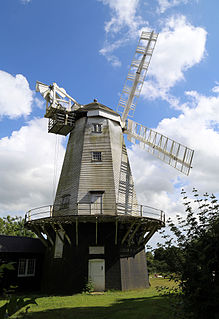
King's Mill or Vincent's Mill, Shipley, West Sussex, England, is a smock mill built in 1879.

Herringfleet Mill or Walker's Mill is a Grade II* listed smock mill at Herringfleet, Suffolk, England, Now in a bad state of repair with two of the 4 sails removed.

Chesterton Windmill is a 17th-century cylindric stone tower windmill with an arched base, located outside the village of Chesterton, Warwickshire. It is a Grade I listed building and a striking landmark in south-east Warwickshire.

Stembridge Tower Mill in High Ham, Somerset, England, is the last remaining thatched windmill in England. The mill is a grade II* listed building.

Brograve Mill is a windpump located on Brograve level in the parish of Sea Palling within the Norfolk Broads National Park, United Kingdom. It can be found at grid reference TG448235 and is approximately 1 mile north of Horsey Mere. The mill is a Grade II listed building.

Denver Windmill is a Grade II* listed tower mill at Denver, Norfolk, England.

Hunsett Mill is located on the east bank of the River Ant one mile north of Barton Broad in the English county of Norfolk. The Windmill is 1.2 miles south west of the town of Stalham. The mill structure is a grade II listed building.

Clayrack Drainage Windmill is located at How Hill in the English county of Norfolk. It is on the east bank of the River Ant close to How Hill, a large Edwardian building which houses the Norfolk Broads Study Centre. The Drainage mill is 1¾ miles west of the village of Ludham.
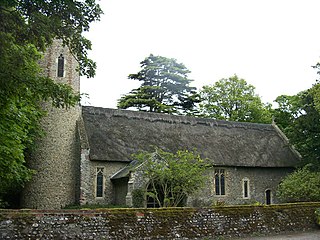
Horsey is a village and civil parish in the English county of Norfolk within The Broads national park. It covers an area of 8.49 km2 (3.28 sq mi) and had a population of 99 in 40 households at the 2001 census. At the 2011 Census the population remained less than 100 and was included in the civil parish of Sea Palling. For the purposes of local government, it falls within the district of North Norfolk.

Davison's Mill, also known as Stelling Minnis Windmill, is a Grade I listed smock mill in Stelling Minnis, Kent, England that was built in 1866. It was the last windmill working commercially in Kent when it closed in the autumn of 1970.

Argos Hill Mill is a grade II* listed post mill at Argos Hill, Mayfield, East Sussex, England

Stone Cross Windmill is a grade II* listed tower mill at Stone Cross, Sussex, England which has been restored and is open to the public. The mill was also known as Blackness Mill and the White Mill.
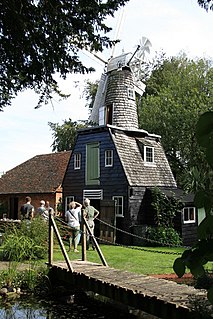
Buckland Windmill is a grade II listed smock mill at Buckland, Surrey, England which has been restored to working order. It is the only surviving wind saw mill in the United Kingdom.
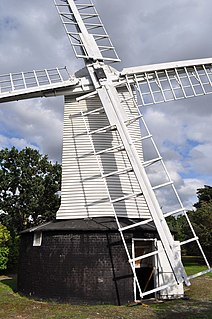
Holton Windmill is a Grade II listed post mill at Holton, Suffolk, England which has been preserved as a landmark.

Thelnetham Windmill, also known as Button's Mill is a Grade II* listed tower mill constructed of brick. The windmill is located at Thelnetham, Suffolk, England. It was built in the early nineteenth century to grind wheat into flour. Thelnetham windmill worked by wind power until 1924, latterly on two sails, after which it became derelict.

Crux Easton wind engine is a Grade II listed Titt wind engine, used as a windpump, at Crux Easton, Hampshire, England, which has been restored to working order.
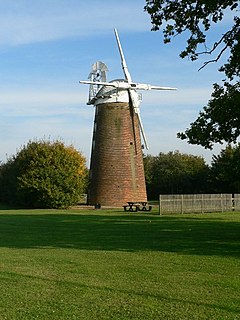
Norwich Road Mill or Fendick's Mill is a Grade II listed tower mill at East Dereham, Norfolk, England which was most recently restored and reopened to visitors in 2013.
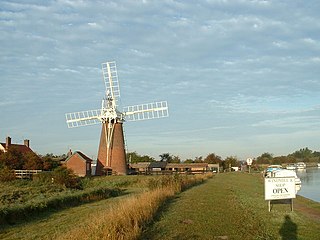
Stracey Arms Windpump is a windpump located at Tunstall in the civil parish of Halvergate, Norfolk, England. It is a grade II* listed building.





















